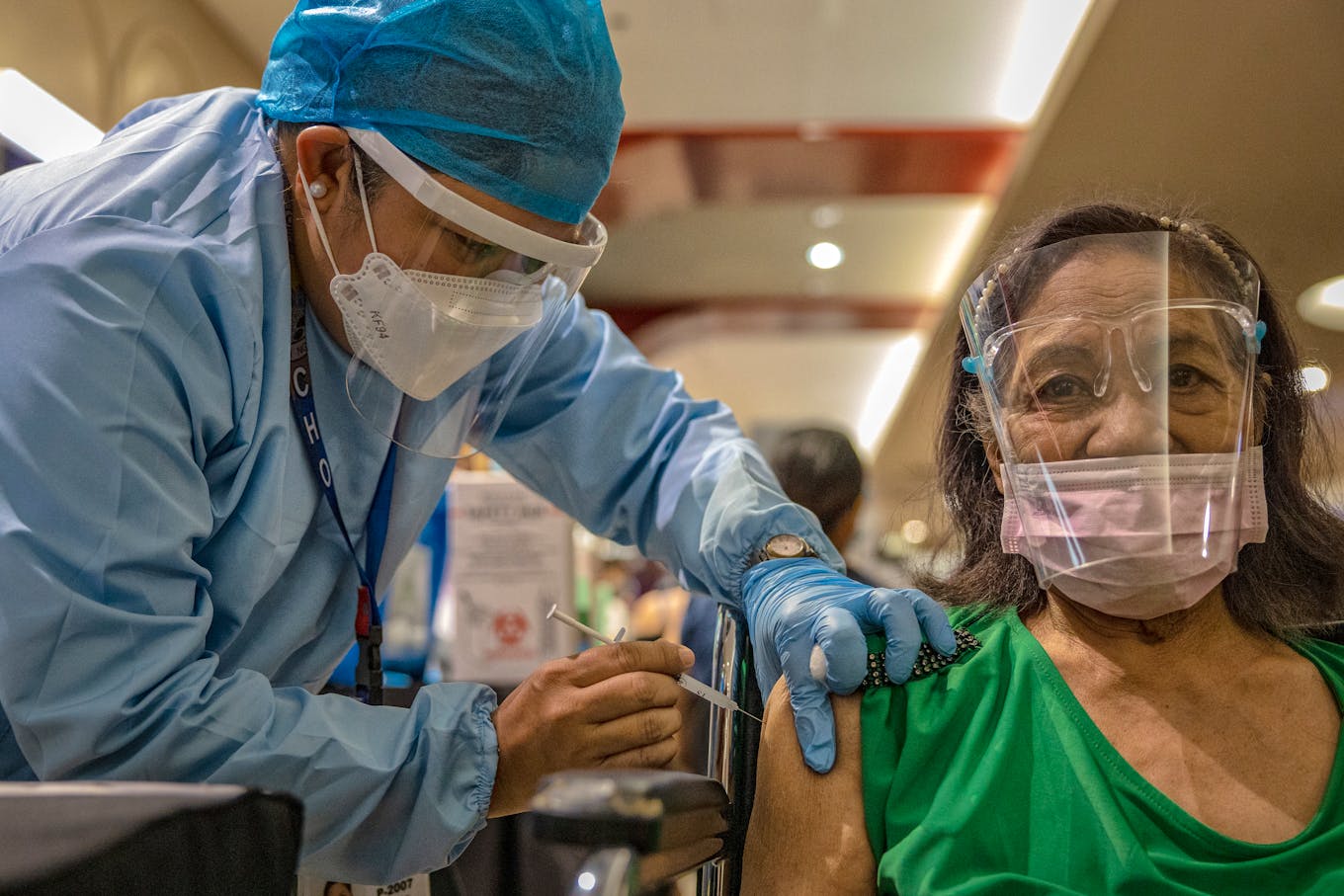Covid-19 is no longer a global health emergency, announced the World Health Organisation (WHO) early this month. The statement comes more than three years after it first declared the coronavirus outbreak a public health emergency of international concern in January 2020, before subsequently raising it to a global pandemic in March 2020.
To continue reading, subscribe to Eco‑Business.
There's something for everyone. We offer a range of subscription plans.
- Access our stories and receive our Insights Weekly newsletter with the free EB Member plan.
- Unlock unlimited access to our content and archive with EB Circle.
- Publish your content with EB Premium.
“For more than a year, the pandemic has been on a downward trend,” said Dr Tedros Adhanom Ghebreyseus, Director-General of the WHO, in a statement. “It is therefore with great hope that I declare Covid-19 over as a global health emergency.”
However, the WHO chief cautioned that the “virus is here to stay,” underscoring that in the last few weeks, Covid-19 claimed a life every three minutes.
The virus, which has been confirmed in almost every country, has infected 765 million people globally. While the estimated global death toll is around seven million, the WHO official said that the true figure was “likely” closer to 20 million deaths — nearly three times the estimate — and he warned that the virus remains a “global health threat.”
“It has caused severe economic upheaval, erasing trillions from GDP, disrupting travel and trade, shuttering businesses, and plunging millions into poverty,” remarked Ghebreyseus, adding that the pandemic has “laid bare the searing inequalities of our world, with the poorest and most vulnerable communities the hardest hit.”
“
Perhaps this is an opportunity for leadership from Asia, in particular the parts of Southeast Asia with relatively well-developed public health systems such as Thailand, Malaysia and Singapore to take the lead where the traditional leaders in North America and Europe are limited by political issues and unable to provide clear scientific leadership.
Dr Paul Tambyah, president, Asia Pacific Society of Clinical Microbiology and Infection
True cost
In 2020, 51 countries – including 44 emerging economies – got the assessment of their government debt risk rating and creditworthiness downgraded due to losses brought on by the pandemic, according to the World Bank.
A paper published recently by pharmaceutical company MSD claims that the true economic burden of the Covid-19 pandemic has been severely “underestimated,” after looking into the territories of Australia, Hong Kong, Singapore, South Korea and Taiwan.
The economic cost of the pandemic in Asia Pacific markets ranged from US$2.6 billion (0.6 per cent of GDP) in Singapore, to US$17.0 billion in Australia (1 per cent of GDP) and US$27.5 billion (1.6 per cent of GDP) in South Korea, according to the paper titled A neglected burden: the ongoing economic costs of Covid-19.
The study reports that the pandemic has directly and indirectly cost Singapore around $3.6 billion annually, largely due to productivity losses. The MSD paper further highlighted five critical industries that contributed disproportionately to the sunk costs and losses, namely tourism, food and beverage, education, logistics and healthcare.
In 2021, at least 32 per cent of organisations in Singapore reported that their operations were significantly impacted by Covid-19, most prominently in operations and supply chain.
The study further highlighted that some 30 per cent of Singapore’s aviation sector was furloughed during the height of the pandemic. The industry has since only recovered 80 per cent of its pre-Covid workforce. As lockdowns have eased and international visitors have returned, tourist spending in Singapore only recovered by about 50 per cent of 2019 levels in 2022.
The paper projects that should current pandemic conditions prevail, the annual economic costs of Covid-19 could reach about US$17.0 billion in Australia (1.0 per cent of GDP), US$5.3 billion in Hong Kong (1.4 per cent of GDP), US$2.6 billion in Singapore (0.6 per cent of GDP), US$27.5 billion in South Korea (1.6 per cent of GDP), and US$7.6 billion in Taiwan (0.9 per cent of GDP).
“The overwhelming evidence from our analysis is that the direct and indirect costs of Covid-19 will continue to be a substantial drain on economies across Asia Pacific, far greater than is commonly recognised,” the study concluded.

In 2020, 51 countries - including 44 emerging economies - got the assessment of their government debt risk rating and creditworthiness downgraded due to losses brought on by the pandemic, according to the World Bank. Image: World Bank Photo Collection, CC BY-SA 3.0, via Flickr.
Fresh wave
Even amid talks of the end of the Covid-19 “public health emergency,” a new omicron variant is mounting a fresh wave. The Arcturus strain – also known as omicron variant XBB.1.16 – is now responsible for at least 14 per cent of new Covid infections, according to the Centres for Disease Control and Prevention (CDC) with research indicating that the new strain could be 1.2 times more infectious than the last major sub-variant.
The WHO began monitoring Arcturus in March and subsequently declared it a “variant of interest” in April. Among the symptoms of the new strain is conjunctivitis or pink eye.
Paul Tambyah, a senior consultant in infectious diseases and president of the Asia Pacific Society of Clinical Microbiology and Infection, however, assures that the new wave is nothing to be worried about.
“It is not a concern as there is no significant impact on healthcare utilisation or mortality in any of the countries affected by [new] waves of mild Covid-19 infection. We should be focusing on getting back to where we were in December 2019 but perhaps a little older and wiser,” he told Eco-Business.
Tambyah also highlighted that WHO’s announcement ending the global “public health emergency” was “long overdue,” underscoring the need now for health authorities to re-establish trust and transparency with the public, while acknowledging rife misinformation and anti-science sentiments in countries like the United States.
“Perhaps this is an opportunity for leadership from Asia, in particular the parts of Southeast Asia with relatively well-developed public health systems such as Thailand, Malaysia and Singapore to take the lead where the traditional leaders in North America and Europe are limited by political issues and unable to provide clear scientific leadership,” he concluded.
Lasting inequality
The Covid-19 pandemic has laid bare massive global inequality. A study by Oxfam International highlighted that in 2022 one new billionaire was produced every 30 hours during the pandemic, as nearly a million people were pushed into extreme poverty in the same time span. The Profiting from Pain paper highlighted that at least 573 grew their net worth to become billionaires during the Covid-19 pandemic, as 263 million more people inched into extreme poverty.
Organisations like the Migrant Forum In Asia and the Business & Human Rights Resource Centre have called attention to the “wage theft” that disproportionately affects workers in the Southeast Asian states, as conglomerates amass wealth in the West. The pandemic further exacerbated the inequality as concerns about poverty-level wages, discrimination and unsafe working conditions have been flagged. An estimated 25 million workers worldwide are trapped in often slave-like conditions, according to the United Nations, as they are forced to generate up to US$150 billion a year in exploited labour, reports the International Labor Organization.
The pandemic has also contributed to aggravating the already strained waste disposal infrastructure of many developing countries. A WHO study estimates that some 87,000 tonnes of nonbiodegradable personal protective equipment (PPE) ended up in the landfills of developing countries after use, between March 2020 to November 2021 alone.
At present, 30 per cent of healthcare facilities – as high as 60 per cent in the least developed countries – are not equipped to handle the proper waste disposal of medical refuse.
WHO pointed out that over 140 million test kits – with a potential to generate 2,600 tonnes of non-infectious plastic waste – and 731,000 litres of chemical waste (equivalent to one-third of an Olympic-size swimming pool) were shipped in 2022, while over 8 billion doses of vaccine have been administered globally producing 144,000 tonnes of additional waste in the form of syringes, needles, and safety boxes.

















